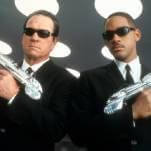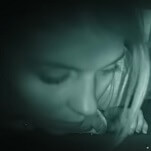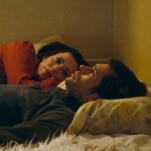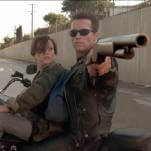If Eve Babitz had never existed, Los Angeles would have had to invent her. The Joan Didions and Nathanael Wests of the world have had their say, their razor-sharp indictments of Hollywood and the City Of Angels standing as the de facto depiction of a West Coast culture that leaves its denizens as vapid and soulless as the red carpet spectacles that bedeck its streets. The town needed an avenging angel, and it speaks to the popular conception of L.A. that the one it received had her work marginalized for almost 40 years.
Thanks to recent rediscovery, and reissues, of her long out-of-print writings, Eve Babitz has re-entered the cultural conversation. Babitz brings with her nearly three decades’ worth of personal and social history about the artists and agonistes, power brokers and pimps, muses and movie stars that moved between Los Angeles’ bedrooms and bars during arguably its most tempestuous and creative era. And if some would cluck disapprovingly at the mention of her louche sexual encounters with Jim Morrison, Steve Martin, Harrison Ford, Ahmet Ertegun, and more, well, Babitz would wonder why they don’t appreciate the art of fucking.
That’s not an exaggeration. As Lili Anolik puts it in Hollywood’s Eve: Eve Babitz And The Secret History Of L.A., the book-length expansion of her 2014 Variety profile on Babitz, “Aha, so it’s not sex and art for Eve, it’s sex is art. And sex, as much as writing, is her métier… Sex is undeniably the source of her energy. It’s what propelled her through her ambiguous and complicated life… To know Eve carnally might be the only way to know her at all.”
It becomes apparent that Babitz’s conquests, her passionate one-night stands and tumultuous relationships, are indeed central to her understanding of not just others but also herself—her interest in the world, and the way desire pushes creativity and curiosity to outrageous extremes. And Eve Babitz knows sex: Her observations of its power could take the form of perfectly executed one-liners (“Which first boyfriend? I had a lot of first boyfriends”), recollections of her own contributions to pop culture minutiae (onetime paramour Steve Martin confirms Babitz was the one who first got him into his signature white suit), or the mere suggestive force of the act when combined with her own magnetism. Here’s the entirety of a letter she wrote as a young woman to Catch-22 author Joseph Heller: “Dear Joseph Heller, I am a stacked eighteen-year-old blonde on Sunset Boulevard. I am also a writer.”
Much of the breezily salacious entertainment value in Hollywood’s Eve comes from these descriptions of close encounters with men of Hollywood legend (and women—photographer Annie Leibovitz was a girlfriend for some time). But like Babitz herself, they are only part of what makes the story so compelling. Babitz was perfectly positioned in the center of sun-dappled L.A. glitz during the 1960s and ’70s, coming of age at a time when producers, actors, musicians, artists, writers, and more all commingled in the smoky bars, art galleries, and restaurants where booze and drugs fueled as much debauchery as artistic inspiration. Babitz was there to observe and participate in all of it: posing nude for a chess match with Marcel Duchamp (resulting in a famed photo), introducing Frank Zappa to Salvador Dalí, being taken under the wing of Joan Didion, idly picking up a temporary career as an album cover designer for the likes of Buffalo Springfield and The Byrds. And it all happened before the age of 28, when she became a contributor for Rolling Stone at the height of its influence and launched a career as a chronicler of Los Angeles’ beautiful and wasted.
Nearly any good biography about a writer makes the reader far more curious to skip the secondhand accounts and read the subject’s original prose. In painting a rich and unusual picture of Babitz’s life and work, Anolik succeeds in this mission. The accompanying excerpts from essay collections Eve’s Hollywood and Slow Days, Fast Company (held up as the avatars of Babitz at her finest) ripple with vivacious wit and penetrating insight. Her accounts of L.A.’s glossy appeal make for a seductive counterpoint to the lacerating Didions of the world, progressing from early retorts to hometown criticisms that are funny but too defensive, until by Slow Days she has hit on a perfect blend of breeze and don’t-give-a-fuck insularity:
People with sound educations and good backgrounds get very pissed off in L.A. “This is not a city,” they’ve always complained. “How dare you people call this place a city!”
They’re right. Los Angeles isn’t a city. It’s a gigantic, sprawling, ongoing studio. Everything is off the record. People don’t have time to apologize for its not being a city when their civilized friends suspect them of losing track of the point.
As biographer, Anolik is an unflinching and often excellent writer capable of capturing the strange mystique of her elusive prey, even detailing her own lengthy and frustrating process of cajoling the now-reclusive writer from her darkened apartment via promises of free meals and delivered sweets. Babitz’s reticence is understandable. She more or less disappeared from public view following a horrific accident in 1997, which left her with third-degree burns on more than half of her body, a dark turn for a woman who had found a joyous appreciation in her physical form and its power to entrance.
But even as Anolik offers candid assessments of Babitz, her family, and the players of the bygone L.A. scene, she can’t resist the urge to engage in a little myth-making, turning the former “It Girl” into a phoenix of heroic iconoclasm, a woman without regrets who has bent life to her will and lived free from conventional restraints. In Anolik’s hands, Babitz’s downfall due to drugs sounds less like the standard tragic narrative and more like a victory against stifling social norms. The writer may ascribe Babitz the mentality of “a child” who refuses to mature, but she also grants her near-mythological status:
So eagerly does Eve court corruption, so exuberantly does she participate in her degradation, so merrily does she roll along the path of sin, that she’s incorruptible, undegradable, and beyond reproach. She’s naughty, certainly, but bad, never. Is an innocent no matter how depraved her conduct. A lewd angel.
Anolik makes the case that her outsized version of Babitz might be the correct one. Eve Babitz is a fascinating figure, more so than many of the famous contemporaries with whom she shared a bed, and her persona (and the seemingly never-ending parade of juicy anecdotes it generated) grabs the imagination until the final pages.
Some passages may pull the modern reader up short, and with good reason. Anolik largely refuses to pass judgment on the sometimes horrifying men of this narrative and their behavior, instead following her subject’s lead when recounting certain abusive incidents. These dark moments are jarring among all the empowered behavior Babitz exhibits, a reminder that for all the freewheeling sexuality of its female characters, they still resided within the confines of a culture too comfortable with denying women their agency. But this deepens the contradictions and questions that make up Eve Babitz and the world in which she pushed, poked, and fucked in exploration of a richer and more fulfilling existence. The writing endures, available for all to savor the language of an author who wielded it with glorious abandon, combining surgical precision with sprawling experimentation. And now the woman herself will endure as well, in a biography that celebrates her with equally contradictory affection.









































